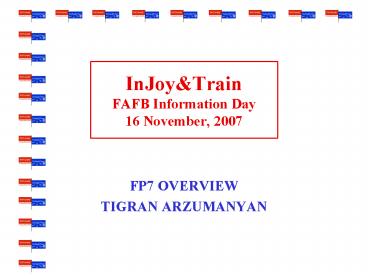InJoy PowerPoint PPT Presentation
1 / 18
Title: InJoy
1
InJoyTrainFAFB Information Day16 November, 2007
- FP7 OVERVIEW
- TIGRAN ARZUMANYAN
2
What is the structure of FP7?
Cooperation Collaborative research
Ideas Frontier Research
People Human Potential
Capacities Research Capacity
Joint Research Centre (non-nuclear)
Joint Research Centre (nuclear)
Euratom
3
Which are the Thematic Priorities?
Cooperation Collaborative research
- 10 Thematic Priorities Themes
- Health
- Food, agriculture and fisheries and biotechnology
(FAFB) - Information and communication technologies
- Nanosciences, nanotechnologies, materials and new
production technologies - Energy
- Environment (including climate change)
- Transport (including aeronautics)
- Socio-economic sciences and the humanities
- Space
- Security
4
Capacities Research Capacity
- Research infrastructures
- Research for the benefit of SMEs
- Regions of knowledge
- Research potential of Convergence Regions
- Science in society
- Support to the coherent development of research
policies - International cooperation
5
FP Budget
FP1 19841987 FP2 19871991 FP3 19911994
FP4 19941998 FP5 19982002 FP6
20022006 FP7 20072013
Approx. figures, including EURATOM
6
FP7 Target audience
- Participation in FP6 (and FP7) is open to all
interested parties (legal entities), including - Research centres (public or private)
- Universities
- Industry (SME or not)
- International organisations
- Industrial associations, professional bodies,
consumer associations, etc. - Physical persons
- Participation is open to parties from non-EU
countries
7
International Cooperation in FP7 International
Co-operation PARTNER COUNTRIES
- 1- Associated countries
- 2- Industrialized countries (USA, Canada, Japan)
- 3- International Co-operation Partner Countries
(ICPC) - Countries neighbouring the EU (Mediterranean
partner Countries, Western Balkans, Eastern
European and Central Asian countries) - Developing countries, focussing on their needs
(ACP, ASIA, Latin America) - Emerging economies (e.g. China, India, Brazil,
Russia, South Africa)
8
FP7 Minimum conditions for participation
- Generally, 3 independent participants from 3
Member States or Associated Countries (or the JRC
or an international European interest
organisation) - Additional or different conditions may apply,
depending on specific workprogramme and type of
project - E.g., ICPC-oriented projects (SICA) will,
generally, require 4 independent participants, 2
of which from different MS/AC and 2 from
different ICPC countries
9
FP projects possible activity types
- Research and technological development
- Demonstration
- Training
- Coordination activities
- Support activities
- Integration activities/ Others
- Management
- Note Different activity types have different
funding levels!
10
FP projects Funding schemes
- Each funding scheme, i.e., project type, allows
for a certain set of activity types. In FP7,
calls will be addressing - Small and Large Collaborative projects (in FP6,
STREP/IP) - Networks of Excellence
- Coordination/support actions
- Fellowships (Marie Curie scheme)
- Research projects for third parties (e.g., SMEs)
- Individual projects (ERC)
11
FP7 projects From the proposal to the contract
12
FP7 margin for a bottom-up approach
- The Marie-Curie scheme
- The Ideas area
- The Research for the benefit of SMEs
- SME associations
- Individual SMEs
13
FP7 Funding
- Principle of co-financing no-profit
- Grants
- Reimbursement of eligible costs
- Flat rates (percentage of direct costs for the
indirect cost or scale of unit costs) - Lump sum amounts
- Combination
14
FP7 Maximum funding rates
- In general
- RTD activities 50,
- (up to 75 for Public bodies, education
establishments, non-profit research
organisations, SMEs) - Demonstration activities 50
- Management, support, coordination, training
activities 100
15
FP7 Intellectual property
- Higher flexibility to exploit generated knowledge
- In principle, each partner owns the knowledge
they generate (but joint ownership also possible) - The EC contract may set restrictions to transfer
of ownership - The consortium agreement can further clarify
ownership of knowledge and exploitation
capabilities
16
Getting support for participation
- National Contact Points or Information Contact
Points or equivalent structures receive training
and support from the EC - Specific support actions (e.g. INJOYTRAIN)
- CORDIS (http//cordis.europa.eu/fp7 a very rich
source of information!) - CORDIS Partner Search
- http//cordis.europa.eu/fp7/partners_en.html
17
Getting involved
- Get informed (workprogramme, ETP documents,
policy background, scientific developments, ) - Work on networking
- CORDIS Partner Search Tool
- Dont hesitate to ask your NCP/ICP for advice!
18
- THANK YOU
- TIGRAN ARZUMANYAN
- tarznip_at_sci.am

